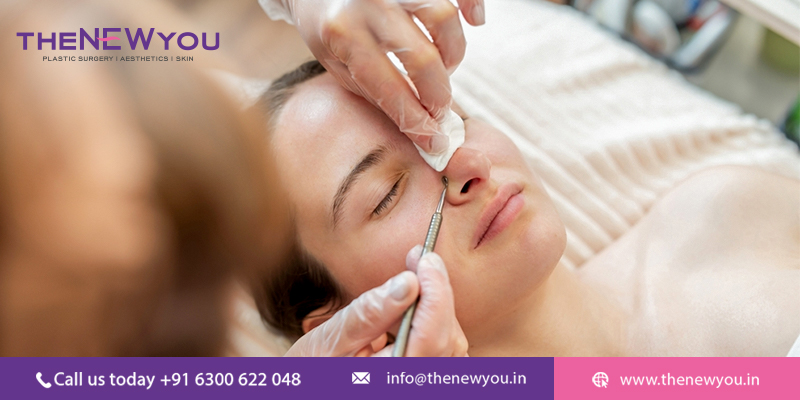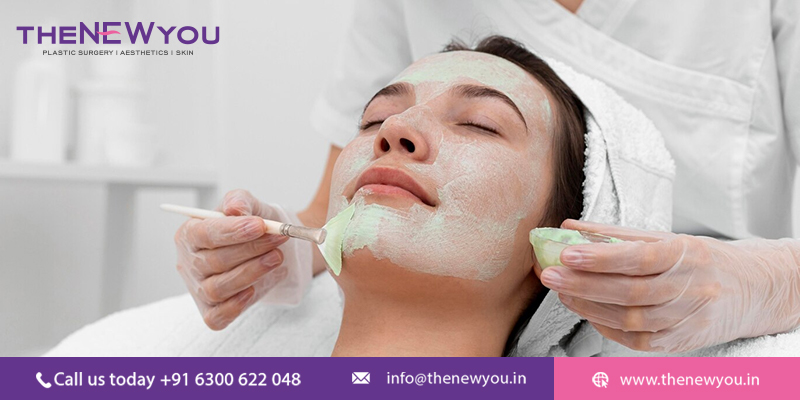Aging mostly shows up on your skin and as you age your skin steadily appears dull as it gradually loses its luster. This is largely due to the build-up of dead skin cells that amplify the aging process. Well, a solution to most of your problems may turn out to be a chemical peel treatment. What are chemical peels?
A chemical peel helps in skin rejuvenation, it is a procedure wherein a chemical solution is applied to peel the top layer and gives you smooth and younger-looking skin.
It is a process where the dead skin cells from the skin surface are sloughed off to activate the growth of healthy new cells. It is one of the most popular nonsurgical cosmetic procedures and treats numerous problems such as scars, skin discoloration, and wrinkles.
How is a Chemical Peel Performed?
The treatment is carried out according to the thickness of one’s skin; all these factors can play a major role in fixing the skin.
The first step of the procedure is cleaning up the skin thoroughly. Your dermatologist may use medications such as glycolic acid and Retin A to prep your skin. They may also suggest some antibiotics or antiviral medications and the solutions used are as follows lactic acid, salicylic acid, TCA or carbolic acid is applied to the target area that is the skin.
What are Different Types of Chemical Peel?
There are mainly three types of chemical peels or anti-aging treatments to look younger and are used to cater to the different requirements of different skin conditions. These types are as follows:
1. Superficial Peels – These are the mildest chemical peels you can find and can be used for different skin types. In this treatment, mild diluted acid is used. Glycolic acid is most preferred in this case. In some cases, dry ice or solid carbon dioxide may also be used.
2. Medium Peels – The potency of medium peels are a little stronger and it helps to soak inside a little deeper into your skin than the medium peels. In some cases, they may cause a burn on your skin. The type of acid used is Trichloroacetic acid (TCA, this is the main agent used in medium peels.
3. Deep Peels – Deep Peel’s soak is the peels that sink the deepest inside the skin, almost several layers, and cause a burn. Deep peels may also act like bleach and may not be used on darker complexions. A chemical called phenol is used in phenols. Deep peels are used only once.
Now, that you have discovered different types of chemical peels, know all about the after-effects too. Chemical peels, as we know can help greatly to resolve some of the most common skin issues. They are a passport to getting brighter smoother skin in a short time. How soon can your skin recover from the treatment and the most important question is there any side effects to this procedure?
To answer the above questions recovery and side effects are largely dependent on the skin’s sensitivity. It is normal to experience a range of side effects as your skin transforms after the post-peel renewal process. Usually, you may feel a slight tingling or burning, however, they usually subside quickly.
What happens after a chemical peel?
Professional peel side effects include some of the following symptoms such as redness, dryness, itching or irritation apart from tightness, swelling, peeling, or scabbing. After, 2 or 3 days your skin may appear tanned or flaky as your skin peels away to reveal more radiant, new skin. You need to take proper care of your skin after chemical peels and avoid direct sun exposure. Take a good look at some of the post-chemical peel care here.
Proper Post-peel Skin Care
If you are undergoing chemical peels at a clinic under an experienced dermatologist, you can minimize your skin’s downtime, when you follow some of the below-mentioned tips.
1. Wash your face with cool water- Cool or cold water always feels better than lukewarm water and it helps reduce the tingling and burning sensations.
2. Moisturization is a must- Since chemical peels affect your skin’s protective barrier, it’s important to strengthen the exterior barrier with a medium-to-thick moisturizer. Also, continue to drink water as it helps avoid dehydration.
3. Don’t forget to apply sunscreen- A sunscreen with high SPF is a must, as high as 30. Avoid direct sun exposure as it may accelerate the skin aging process.
4. Take it easy for a while- By that we mean avoid strenuous workouts, dry saunas, and steam rooms. Saunas can accelerate blood circulation and make the post-peel sensations worse. Wait till your skin is back to its new normal before pursuing such activities.
5. Over-exfoliation is a strict no-no – Peels are strong exfoliants by themselves. This is why you must avoid separate exfoliants such as a scrub, brush or exfoliating cleanser for at least 3-4 days post your chemical peeling treatment. Over-exfoliation can lead to more redness or sensitivity, so wait for your skin to heal up.
Once your skin starts feeling normal, you can resume your daily skin routine.
You will be able to see results in very few days. However, the recovery largely differs from person to person. A light chemical peel requires very little downtime, a medium chemical peel requires 3 to 5 days of recovery time and a deep chemical peel require a little over 7 days for complete recovery.
Though people freak out at the very mention of chemicals the bottom line is that the sources of these chemicals are harmless such as salicylic acid, which comes from wintergreen, lactic acid from sour milk, and glycolic acid comes from sugar cane. So, these chemicals are not really ‘frightening’ rather they are eco-friendly, unproblematic, and deemed safe for all skin types.
The benefits of chemical peels are many and all the different types of chemical peels can help treat various skin issues. Deep chemical peels can treat the most troublesome skin problems such as serious acne, scarring, and birthmarks.











